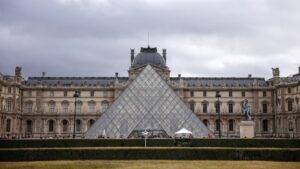
The Cabinet of Ministers is transferring State Enterprise “Forests of Ukraine” to the status of a joint-stock company, but 100% of the shares will remain in state ownership, Prime Minister Yulia Svyrydenko announced.
“Today, at a government meeting, a number of decisions were made that are important for the stability and development of the forestry industry. State Enterprise ”Forests of Ukraine” is transitioning to the status of a joint-stock company. We are doing this to ensure a more effective corporate governance model with transparent reporting and to increase the competitiveness of the enterprise,” Svyrydenko wrote on Telegram following the results of Friday’s government meeting.
According to her, the transformation of the enterprise into a joint-stock company does not imply privatization—100% of the shares remain in state ownership.
Subsequently, the prime minister’s message was edited, and information about this decision was removed.

Metinvest Shipping, the logistics division of Metinvest Group, earned a net profit of UAH 114.146 million in January-September this year, compared with a net loss of UAH 16.227 million in the same period last year.
According to the company’s interim report, which is available to Interfax-Ukraine, its profit in the third quarter of 2025 amounted to UAH 81.299 million. Revenue for this period decreased by 13% to UAH 1 billion 752.366 million. Undistributed profit at the end of September amounted to UAH 1 billion 367.237 million.
The company ended 2024 with a loss of UAH 67.393 million, compared to UAH 729.472 million in 2023.
Metinvest Shipping LLC has been part of the Metinvest Group since 2006. The company has branches in Mariupol (operations temporarily suspended) and Odesa. The company’s activities cover the entire range of freight transport services: organization of road and rail transport, customs clearance, forwarding, ship agency, and chartering of the maritime fleet.
Since 2019, the company has been inspecting metal products of Metinvest Group enterprises. Between 2010 and 2024, Metinvest Shipping handled over 364 million tons of cargo, provided agency services for over 9,000 vessels, and transported approximately 896 million tons of cargo by rail. The company owns more than 2,300 units of rolling stock, including 11 diesel locomotives.
As of December 31, 2024, the average number of employees in the company was 220.
Metinvest Holding LLC owns a 100% stake in Metinvest Shipping LLC ”
The LLC’s authorized capital is UAH 25.012 million.
Metinvest is a vertically integrated group of mining and metallurgical enterprises. Its enterprises are located in Ukraine, in the Donetsk, Luhansk, Zaporizhia, and Dnipropetrovsk regions, as well as in European countries.
The main shareholders of the holding company are SCM Group (71.24%) and Smart Holding (23.76%). Metinvest Holding LLC is the managing company of the Metinvest Group.

In January-October 2025, Ukraine increased imports of tomatoes by 4.3% to 81.82 thousand tons and cucumbers by 13.6% to 109.56 thousand tons compared to the same period last year, according to the State Customs Service.
According to the published statistics, in monetary terms, tomato imports increased by 18.2% to $16.92 million during the reporting period, and cucumber imports increased by 30% to $23.39 million.
The main imports of tomatoes at this time came from Turkey (64.3% of all supplies), Poland (11.7%), and the Netherlands (11.18%). The top three suppliers of cucumbers to Ukraine were Turkey (88.2%), Spain (3.7%), and Finland (2%).
A year ago, the main suppliers of tomatoes to Ukraine in January-October were Turkey (73.6%), Poland (12.3%), and Morocco (5.9%), while the main suppliers of cucumbers were Turkey (85.2%), Poland (4%), and the Netherlands (3.1%).
Tomato exports in January-October this year amounted to 393 tons, compared to 301 tons a year ago. This year, they were purchased by Moldova (60.6%), Poland (36.4%), and Singapore (0.8%), while last year they were purchased by Moldova (87.4%), Lithuania (7.6%), and Malaysia (1%).
In the first 10 months of 2025, 2.44 thousand tons of Ukrainian cucumbers were supplied to foreign markets, compared to 1.01 thousand tons in the same period last year. They were most actively purchased by Poland (52.3%), Estonia (37.5%), and Moldova (8%). A year ago, the top three were the same, but their shares in the procurement structure differed: Estonia accounted for 54.7% of supplies, Poland for 26.3%, and Moldova for 10.5%.
As reported, in July 2025, Ukraine introduced anti-dumping duties on imports of fresh cucumbers and tomatoes from Turkey at 20.1% and 26.9%, respectively, for a period of five years. These measures were applied to protect Ukrainian producers from dumped imports, which caused damage to domestic greenhouse farms.

The Kryvyi Rih Mining and Metallurgical Plant PJSC ArcelorMittal Kryvyi Rih (AMKR, Dnipropetrovsk region) has purchased and commissioned a new gantry crane in the repair shop (RC) of the mining department (MD).
According to information from the company in the corporate newspaper Metallurg, the use of the new crane has made the movement of goods safer.
It is specified that the crane replacement project was implemented as part of the work to achieve FPS corporate standards for occupational safety.
Lyubov Yevseyanko, lead engineer of the GD project implementation department, noted that such cranes are manufactured individually to meet the needs of those who will use them.
“First, together with experts from the repair shop, we specified what equipment they needed. Based on this, a drawing was made, describing the parameters of the future crane. Then we worked with companies that are capable of manufacturing such a crane with high quality, in accordance with standards and within a timeframe that would satisfy us. From several options, we chose the one that best met the criteria. Work began on the manufacture of the equipment,” she said.
Igor Maly, head of the RC GD, highly praised the work of the contractors who manufactured the crane and then participated in its installation and commissioning.
“Our workshop performs repairs and manufactures metal structures, spare parts, assemblies, and mechanisms. We really needed this crane. It replaced the old one, which was no longer safe to use. There was also an urgent need for more powerful equipment: the old crane had a lifting capacity of 5 tons, but recently we have been working more often with heavier products and materials,” explained the workshop manager.
He added that the contractor, the Kyiv Lifting and Transport Equipment Plant, manufactured the crane quickly, efficiently, and in accordance with the requirements. Along with the crane, the rail track on which it moves was also replaced.
ArcelorMittal Kryvyi Rih is the largest manufacturer of rolled steel in Ukraine. It specializes in the production of long products, in particular, rebar and wire rod. The enterprise has a full production cycle, and its production capacity is designed for an annual output of over 6 million tons of steel, more than 5 million tons of rolled products, and over 5.5 million tons of pig iron.
ArcelorMittal owns Ukraine’s largest mining and metallurgical complex, ArcelorMittal Kryvyi Rih, and a number of small companies, including ArcelorMittal Beryslav.

From the beginning of next year, the Louvre Museum in Paris will significantly increase the cost of admission tickets for most visitors from countries outside the European Union and the European Economic Area (EEA). This was reported by Euronews Serbia and the Serbian newspaper Politika, citing a decision by the museum’s board and BBC reports.
From 14 January 2026, tickets for tourists from countries outside the EU and the EEA (which, in addition to EU countries, includes Norway, Iceland and Liechtenstein) will increase in price from €22 to €32, i.e. by 45%.
The new rates will apply, in particular, to citizens of the United States, the United Kingdom, China, and all countries that are not members of the EU or the EEA – the countries of the Western Balkans (including Serbia, Montenegro, North Macedonia, Albania, Bosnia and Herzegovina), Ukraine, Russia, Turkey, the Middle East, Africa, Latin America and most of Asia.
According to the Louvre itself, the museum was visited by about 8.7 million people in 2024, of whom approximately 69% were foreign tourists; more than 10% of the flow was accounted for by US citizens, and about 6% by Chinese visitors. The French authorities and the museum’s management expect that the price increase for non-Europeans will bring in tens of millions of euros in additional revenue, which will be used to strengthen security and carry out a large-scale renovation of the building and exhibition spaces.

On 25 November 2025, the Ukrainian House hosted a gala ceremony to award the winners of the annual competition for professionals in the Ukrainian pharmaceutical industry, Panacea-2025, the main national event that recognises market leaders, innovations and industry achievements.
The ceremony was traditionally hosted by Timur Miroshnichenko, and the musical atmosphere of the evening was created by the band KADNAY.
The pharmaceutical industry in 2025: a year of courage, innovation and resilience
The awards ceremony brought together the leading companies, experts and innovators of the year.
In 2025, the Ukrainian pharmaceutical industry continues to operate in conditions of full-scale war and economic instability. Despite the pressure of circumstances, the market demonstrates a unique ability to adapt: companies invest in innovation, develop new approaches to products and services, implement digital solutions and support patient access to quality treatment.
This year’s ceremony was an evening of gratitude to all those who are making the Ukrainian healthcare system stronger and the pharmaceutical industry more competitive on a global level. Before announcing the winners, guests honoured the defenders of Ukraine with a minute of silence.
Winners of Panacea-2025
COMPANY OF THE YEAR
AI Excellence Award, Artificial Intelligence in Pharmacy
Winner: Roche
The company was recognised for its breakthrough in the application of artificial intelligence and the implementation of the project ‘Screening for diabetic retinopathy using AI’ — an innovation that gives patients access to fast and accurate diagnostics.
Investors in innovative treatment during wartime. International sponsors of clinical trials
Winner: MSD
The company was recognised for its continued support of clinical trials in Ukraine, increased investment in scientific programmes, and ensuring patients have access to modern treatments even during wartime.
PROJECT OF THE YEAR
Introduction of eCTD in Ukraine
Winner: State Expert Centre of the Ministry of Health of Ukraine
Ukraine has switched to the international format of registration dossiers eCTD, used by the EU, the US and leading regulators around the world, in record time. This step has already been recognised as one of the most important digital breakthroughs in Ukrainian pharmaceuticals.
EDUCATIONAL PROJECT OF THE YEAR
Polpharma Academy
The project was recognised for creating a modern interactive educational space for doctors with a focus on practice, professional support and uniting the medical community around knowledge and development.
DRUG OF THE YEAR — OVER-THE-COUNTER GROUP
2025 winners:
• AMIKSIN IS, Interchem
• PROKTOZAN NEO, STADA
• LAFEROBION, STADA
• NIKSAR, Berlin-Chemie Menarini
• HILO-KOMOD, Sona Exim
These drugs have become reliable ‘first-line solutions’ for patients in 2025.
Dynamic leader in the low-cost segment
Winner: PULMOBRIZ, MOVIHealth
The drug was recognised for its high efficacy, affordability and significant contribution to the treatment of seasonal respiratory diseases.
Panacea-2025 was made possible thanks to the support of:
• Analytical partners: IQVIA, SMD, Business Credit
• Professional associations: AIMP, AVLU, APRAD, APAU, Association of Medical Device Market Operators, Pharmaceutical League of Ukraine, Ukrainian Association of Evidence-Based Healthcare
• Legal partner: GelOn
• Tourism partner: DinAdis
• Media partners: Pharmaceutical Industry, Interfax-Ukraine
• Organiser: Zdorovo production company
This year’s Panacea has once again proven that the Ukrainian pharmaceutical industry is not just holding its own during the war — it is growing, reforming and boldly implementing global standards.
Innovative solutions, educational projects, support for clinical research and modern approaches to treatment — all this is shaping a new, strong and competitive Ukrainian pharmaceutical industry.
The organisers of the competition thanked all partners and participants for their contribution to the development of the industry and invited the community to the Panacea-2026 ceremony.
Interfax-Ukraine is the information partner of the Panacea Award
